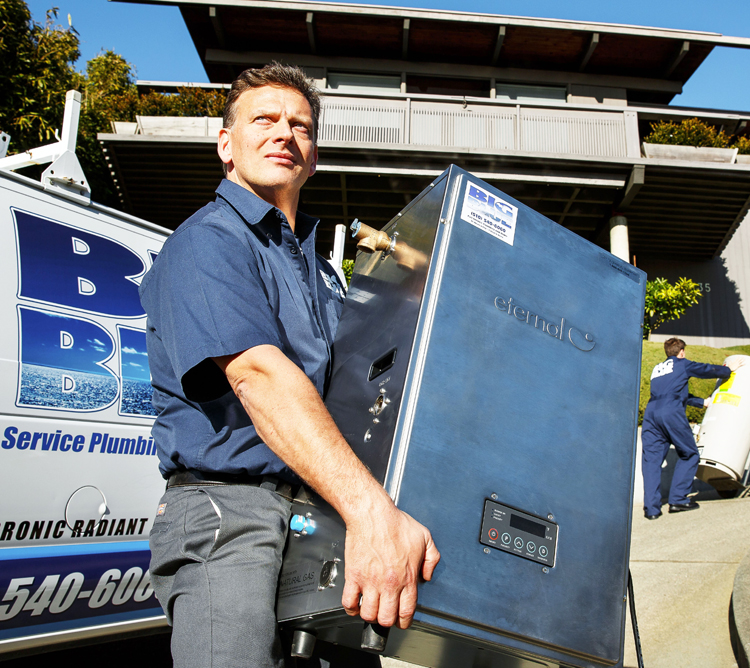Ask an Expert: California's New Low-Flow Plumbing Fixtures Law
 |
|
|
Soon enough, even Eichler owners will have to give up their vintage toilets.
Californians who live in houses built before 1994, including all mid-century modern owners, have historically been exempt from the state's water-saving requirements, under which new houses must be built with low-flow toilets and shower heads. Come January, that will change. A new state law requires houses, apartments, and businesses to replace their fixtures with low-flow models, regardless of when they were built. It's the first of its kind in the nation, and it will affect every Eichler, Streng, Alexander, and other mid-century modern home owners.
The Ventura County Star (syndicated by HuffPo) has a neat summary:
Starting Jan. 1, they won't be able to get final approval for a variety of home improvements -- from replacements of windows to a room addition -- unless they have low-flow plumbing fixtures throughout their properties.
By 2017, the law requires all pre-1994 homes to be retrofitted with low-flow plumbing fixtures plus disclosure of noncomplying fixtures when owners sell. Businesses and multifamily buildings also must disclose whether they meet the law when selling property by that date.
So where does that leave the Eichler owner who now must plan to replace toilets and shower heads? I called Paul Gerrard, with Big Blue Plumbing, based in the East Bay, to find out.
While it may sound like a burden to have to replace your home's plumbing fixtures, Gerrard says the benefits outweigh the hassle and expense. Low-flow plumbing technology has come a long way since Seinfeld took on 'The Shower Head' in 1996.
"Low-flow toilets have had a bit of a bad rap," Gerrard says. "Originally, manufacturers were required to reduce the amount of water per flush, so they just made the tanks smaller and the mechanics stayed the same. The bowl wasn't designed to work with that low amount of water. The latest generation are designed as a complete product. The effect is they flush a lot better with less water. They've done that by increasing the flapper size – the little rubber flap that lifts when you push the lever on your tank. That used to be an inch and a half, but the low-flow toilets are a 2.5 inches in diameter. You're able to get the water into the bowl faster."
Similarly, makers of low-flow shower heads have been perfecting their design. "They do give a satisfying shower with less water," Gerrard says.
The savings are immense: "Water conservation is a real issue, and a lot of older homes have some really large-capacity toilet tanks. They can be 3.5, even 5-gallon tanks. Average person flushes 5 times a day, so that's 25 gallons per person. In a family of four, that's 100 gallons a day," Gerrard says. Low-flow toilets now routinely use less than a gallon and a half, and shower heads save a gallon a minute.
The best advice for homeowners who want to get their upgrade out of the way: Keep it simple. Those ultra low-flow models with separate buttons for nos. 1 and 2? Forget it. "I don't believe the savings in water conservation is so great that it's necessary to add all that cleverness to a toilet tank. It's all stuff that can go wrong."
Gerard's go-to recommendation is the Eco-Drake by Toto, which uses 1.28 gallons per flush. "Toto is really, in my opinion, the leader in the ultra low-flow toilets, as far as what they've done with their manufacturing to make them work better. It seems like everybody follows what Toto does."
As for shower heads, Gerrard says he relies on the Grohe Relaxa. It's not the cheapest on the market, but "I like the shower pattern, as far as the different positions and the different flow that you get from them. I also like that we never get complaints about them after we install them."
Installing fixtures is not the most labor-intensive job a plumber can do – so much of the expense will be in the fixtures themselves. But Gerrard was reluctant to name a specific price for such an upgrade. Suffice to say, the sooner it gets done, the more water gets saved, and that's a good thing all around.
- ‹ previous
- 55 of 677
- next ›




